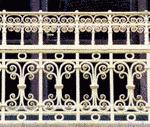metal
1. a. any of a number of chemical elements, such as iron or copper, that are often lustrous ductile solids, have basic oxides, form positive ions, and are good conductors of heat and electricity
b. an alloy, such as brass or steel, containing one or more of these elements
2. the substance of glass in a molten state or as the finished product
4. Astronomy any element heavier than helium
5. the rails of a railway
Collins Discovery Encyclopedia, 1st edition © HarperCollins Publishers 2005
metal
In astronomy, any element heavier than helium; the most abundant metals are oxygen, carbon, and nitrogen.Collins Dictionary of Astronomy © Market House Books Ltd, 2006
Metal
Any of a class of elementary substances which are crystalline when solid and characterized by opacity, ductility and conductivity; mined in a form called “ore” and manufactured to specific applications.
aluminum
A lightweight metal which is malleable and nonmagnetic and has good conductivity; it is a good reflector of heat and light and is resistant to oxidation; it is often anodized for better corrosion resistance, color and surface hardness.

brass
Any copper alloy having zinc as the principal alloying element, but often with small quantities of other elements.

bronze
An alloy of copper and tin, bronze in color, having a substantial admixture of copper to modify the properties of the principal element, such as aluminum bronze and magnesium bronze.


cast iron
A hard, nonmalleable iron alloy containing carbon and silicon, which is poured into a sand mold and then machined to a desired architectural shape.


copper
A metal with good electrical conductivity, used for roofing, flashing, hardware and plumbing applications; when exposed to air, copper oxidizes and develops a greenish “patina” that halts corrosion.
ferrous metal
A metal in which iron is the principal element.
iron
A metallic element found in the earth’s crust, consisting of a malleable, ductile, magnetic substance from which pig iron and steel are manufactured.

lead
A soft, malleable, heavy metal that has a low melting point and a high coefficient of thermal expansion; very easy to cut and work.
stainless steel
A high-strength, tough steel alloy; contains chromium with nickel as an additional alloying element and is highly resistant to corrosion and rust.


steel
A hard and malleable metal when heated; produced by melting and refining it according to the carbon content; used for structural shapes due to its alloy of iron and carbon which has a malleable high tensile strength.


tin
A lustrous white, soft, and malleable metal having a low melting point; relatively unaffected by exposure to air; used for making alloys and solder, and in coating sheet metal.
weathering steel
A high-strength, low-alloy steel that forms an oxide coating when exposed to rain or moisture, which adheres to the base metal and protects it from further corrosion.
wrought iron
A commercially pure iron of fibrous nature, valued for its corrosion resistance and ductility; used for water pipes, water tank plates, rivets, and other forged work.


zinc
A hard bluish-white metal, brittle at normal temperatures, very malleable and ductile when heated; not subject to corrosion; used for galvanizing sheet steel and iron in various metal alloys.
Illustrated Dictionary of Architecture Copyright © 2012, 2002, 1998 by The McGraw-Hill Companies, Inc. All rights reserved
What does it mean when you dream about metal?
Metals are hard but malleable, a potent symbol of strength and character. Metals can also be cold and, because of their association with technology, represent the inhuman side of our society.
The Dream Encyclopedia, Second Edition © 2009 Visible Ink Press®. All rights reserved.
metal
[′med·əl] (astronomy)
In stellar spectroscopy, any element heavier than helium.
(materials)
An opaque crystalline material usually of high strength with good electrical and thermal conductivities, ductility, and reflectivity; properties are related to the structure, in which the positively charged ions are bonded through a field of free electrons which surrounds them forming a close-packed structure.
McGraw-Hill Dictionary of Scientific & Technical Terms, 6E, Copyright © 2003 by The McGraw-Hill Companies, Inc.
Metal
An electropositive chemical element. Physically, a metal atom in the ground state contains a partially filled band with an empty state close to an occupied state. Chemically, upon going into solution a metal atom releases an electron to become a positive ion. Consequently in biotic systems metal atoms function prominently in ionic transport and electron exchange. In bulk a metal has a high melting point and a correspondingly high boiling temperature; except for mercury, metals are solid at standard conditions. Direct observation shows a metal to be relatively dense, malleable, ductile, cohesive, highly conductive both electrically and thermally, and lustrous. When crystals of the elements are classified along a scale from plastic to brittle, metals fall toward the plastic end. Furthermore, molten metals mixed with each other over wide ranges of proportions form, upon slowly cooling, homogeneous close-packed crystals. In contrast, a metal mixed with a nonmetal completely combines into a homogeneous crystal only in one or a few discrete stoichiometric proportions.
McGraw-Hill Concise Encyclopedia of Engineering. © 2002 by The McGraw-Hill Companies, Inc.
METAL
(1)Mega-Extensive Telecommunications Applications Language.
BBS language for PRODOS 8 on Apple II.
METAL
(2)The syntax-definition formalism of the Mentor system.
Metal specifications are compiled to specifications for a
scanner/parser generator such as Lex/Yacc. "Metal: A
Formalism to Specify Formalisms", G. Kahn et al, Sci Comp
Prog 3:151-188 (1983).
This article is provided by FOLDOC - Free Online Dictionary of Computing (foldoc.org)












